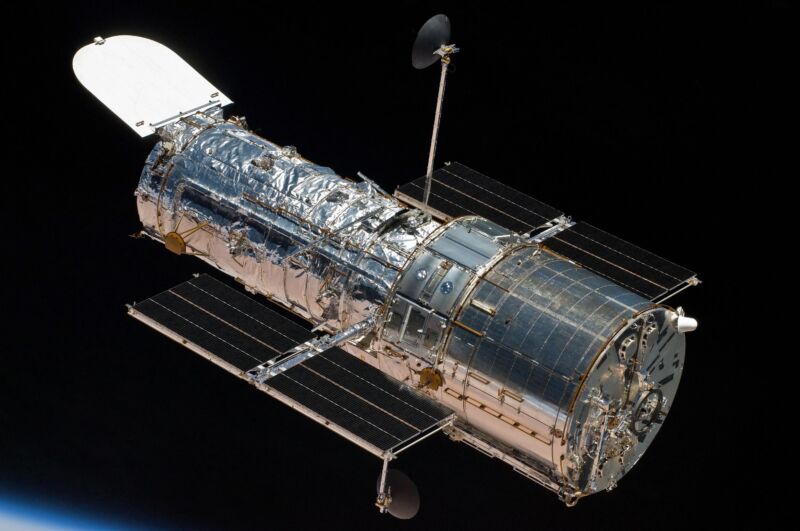
NASA
The Hubble Space Telescope resumed science observations on Friday after ground teams spent most of the last three weeks assessing the performance of a finicky gyroscope, NASA said.
The troublesome gyroscope is a critical part of the observatory’s pointing system. Hubble’s gyros measure how fast the spacecraft is turning, helping the telescope aim its aperture toward distant cosmic wonders.
Hubble still provides valuable scientific data for astronomers nearly 34 years since its launch aboard NASA’s Space Shuttle Discovery in 1990. Five more shuttle servicing missions repaired Hubble, upgraded its science instruments, and replaced hardware degraded from long-term use in space. Among other tasks, astronauts on the last of the shuttle repair flights in 2009 installed six new gyroscopes on Hubble.
Moving parts sometimes break
The gyros have long been one of the parts of Hubble that necessitate the most upkeep. A wheel inside each gyro spins at a constant rate of 19,200 revolutions per minute, and the wheel is, in turn, sealed inside a cylinder suspended in a thick fluid, according to NASA. Electronics within each gyro detect very small movements of the axis of the wheel, which supply Hubble’s central computer with information about the spacecraft’s turn rate. Hair-thin wires route signals from the gyroscopes, and these wires can degrade over time.
Three of the six gyros installed on Hubble in 2009 have failed, and three others remain operational. The three still-functioning gyros are based on a newer design for longer life, but one of these units has shown signs of wear in the last few months. This gyroscope, designated Gyro 3, has always exhibited “consistent noisy behavior,” said Pat Crouse, Hubble project manager at NASA’s Goddard Space Flight Center.
Hubble typically needs three gyros to work normally, so ground controllers shut down Gyro 3 for roughly seven years until Hubble needed it in 2018, when another gyroscope failed, leaving only three of the devices still working.
“Back in August, we saw issues,” Crouse told Ars this week. “It would sort of sporadically output some rate information that was not consistent with the observed spacecraft body rates, but it was short-lived, and we were characterizing what that performance was admire and how much we could tolerate.”
The gyro’s performance worsened in November when it fed Hubble’s control system erroneous data. The gyroscope sensed that the spacecraft was changing its orientation when it really wasn’t moving. “That, then, contributed to an error in attitude that was kind of causing a little bit of drift,” Crouse said.
Automated software on Hubble detected the errors and put the spacecraft into “safe mode” two times last month. Hubble quickly resumed science observations each time but then went into safe mode again on November 23. Hubble managers took some extra time to gather data on the gyro’s health. Engineers commanded Hubble to advance back and forth, and the suspect gyro consistently seemed to work well.
Recognizing that the gyros are prone to failure, engineers devised a new way for Hubble to keep delivering science data even with one operating gyroscope. In this one-gyro mode, Hubble’s control system would acquire inputs from the single gyroscope in combination with magnetometers, Sun sensors, and star trackers. Most of Hubble’s science portfolio would not be affected in a one-gyro mode, but the observatory could have limitations following some faster-moving targets, such as planets, asteroids, or comets in the inner part of the Solar System.
Hubble uses spinning reaction wheels to torque the spacecraft in large movements from one direction to another. The spacecraft doesn’t have any thrusters to control its orientation or adjust its orbit. There are three fine guidance sensors to maintain a lock on guide stars, keeping Hubble stable during scientific observations. Crouse said Hubble’s ground team is also keeping a close eye on these sensors.
One of the fine guidance sensors has shown signs of degraded performance in the last two years, he said. A buildup of debris or lubrication along a bearing appears to be the source of some resistance in the sensor, occasionally causing it to stall.
Another servicing mission?
While Hubble doesn’t match the imaging power and resolution offered by the newer James Webb Space Telescope, the aging observatory still occupies a unique role among NASA’s fleet science missions. Hubble is sensitive to visible and ultraviolet light, while Webb’s sensors are tuned to detect infrared light.
NASA wants to keep Hubble going as long as possible. Even if Hubble’s sensors and instruments are still working, aerodynamic drag will eventually bring the telescope back into the atmosphere because the spacecraft doesn’t have any rocket engines. Each of the space shuttle servicing missions booster Hubble into a higher orbit to counteract the drag.
Hubble is currently flying at an altitude of around 320 miles (520 kilometers). Current predictions propose Hubble would reenter the atmosphere in the mid-2030s, but this depends on the conditions of the upper atmosphere, which change with fluctuations in solar activity.
Last year, SpaceX and NASA announced a feasibility research to ascertain whether it might be possible for a Dragon spacecraft to link up with Hubble and reboost the observatory, extending its orbital lifetime. This six-month research, which was concluded earlier this year, was also expected to look at ways for astronauts on the Dragon capsule to potentially service Hubble. If a servicing mission is deemed possible, swapping out gyros would surely be at the top of NASA’s priority list.
NASA and SpaceX have not released the results of the feasibility research. Last December, NASA also released a ask for information from other US companies to suggest their own commercial solutions for boosting Hubble’s orbit. The agency received eight responses to this solicitation, not including the separate SpaceX feasibility research. In the end, NASA may deduce not to advance forward with a commercial servicing mission to Hubble.
Alise Fisher, a NASA spokesperson, told Ars the agency doesn’t have a projected timeframe for completing its review of the Hubble reboost studies. “We will continue internal evaluations early next year.”

